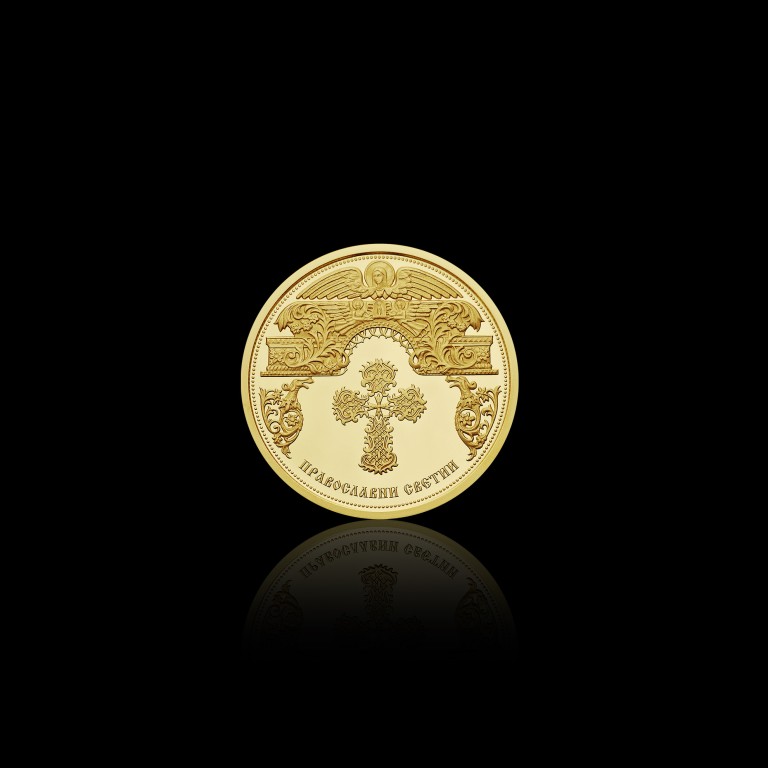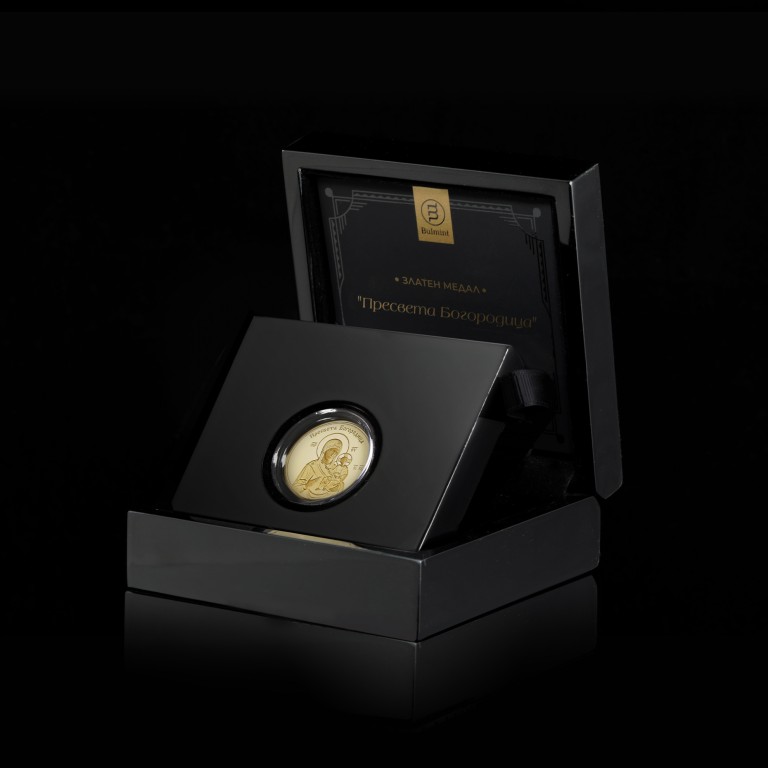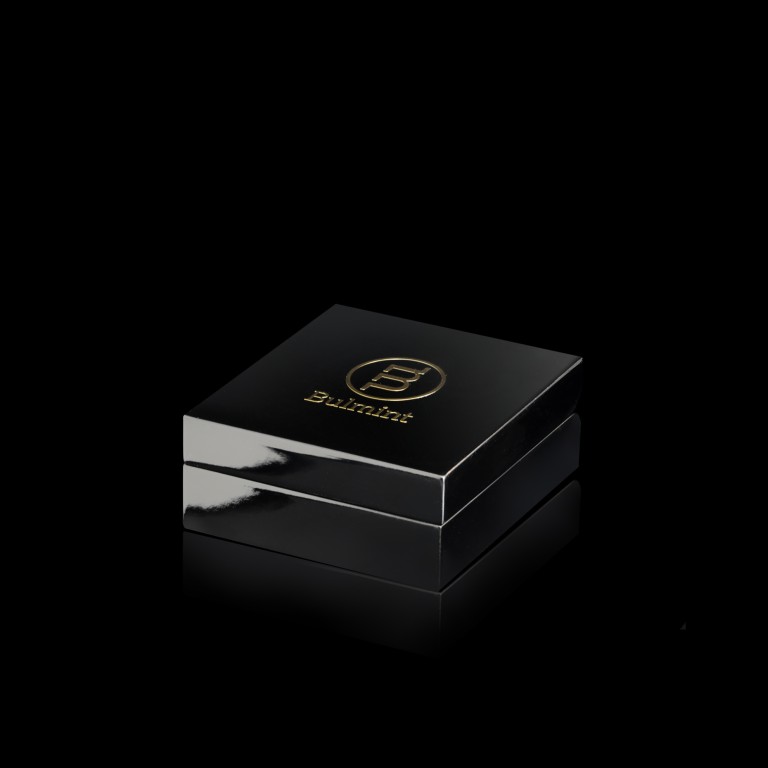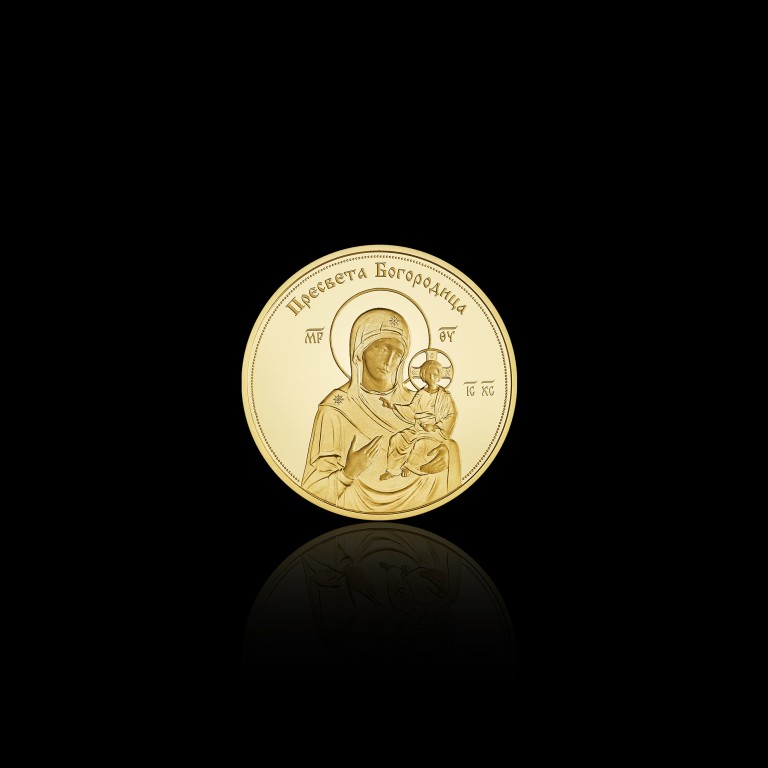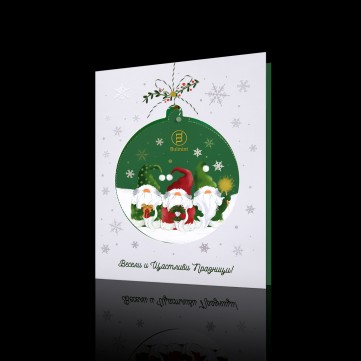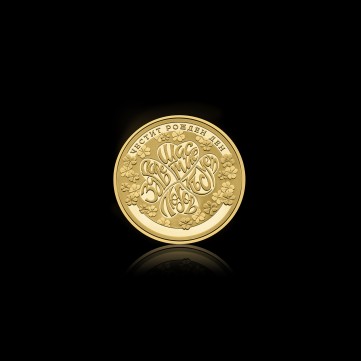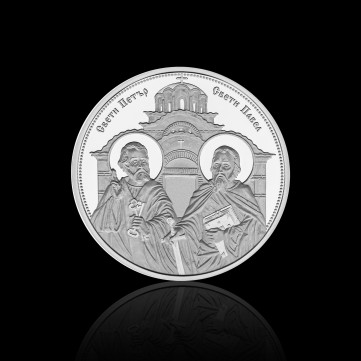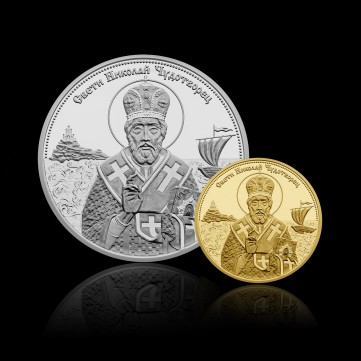Eastern Orthodoxy venerates the Most-Holy Theotokos as the most significant personage in Christianity after the Holy Trinity - more esteemed than all the saints and angels and humanity’s prime intercessor before God. She is the patron saint of the home and family, of women and children, and of motherhood. Three out of the Twelve Great Feasts throughout the year are dedicated to key moments in her life, and a number of less significant holidays celebrate other stories connected to the Mother of God.
The Virgin Mary gold medal is minted in proof matt-gloss quality out of 7.78 g of 999.9 fine gold. It has a diameter of 24 mm. In proof matt-gloss quality it depicts the Virgin Mary in her role as Wayshower (also known as Hodegetria). Upon her left arm, like a throne, sits the Christ Child, His right hand raised in a gesture of blessing. He is holding a scroll, book, or orb, invoking the iconographic image of Christ Almighty. With her right hand, the Mother of God is pointing towards him, symbolically guiding us towards “the way, and the truth, and the life”. The Virgin Mary’s and Jesus’s clothes stand out from the surrounding matt-gloss thanks to a special satin finish. We used the same effect to depict the divine shine of the Saviour’s cruciform halo.
The design of the reverse of the medals in this program is inspired by the richly ornamented iconostasis of the Nativity of the Blessed Virgin Mary Church in Rila Monastery. This stunning example of Revival Period woodcarving was made between 1839 and 1844 and is the work of Atanas Teladur - the founder of the woodcarving movement of the Samokov Art School. We recreated the handcarved ornaments in the finest silver by using contemporary coin-minting technology and placed a detailed Eastern Orthodox cross as the centerpiece of the composition.
This is the second collection in the “Orthodox Saints” program, dedicated to the most exalted holy persons in Eastern Orthodox Christianity. It would make a wonderful and original gift for a name day, a housewarming celebration, the creation of a new family unit or any other significant personal milestone.
The product comes in a black wooden box decoated with a metallic logo, placed inside a raisable nest, making it suitable for both storage and display.
You may opt for a silver proof medal bearing the same design, or to get the Most-Holy Theotokos medal collection as a set.
Metal
Fine Gold
Weight
7.78
g
Purity
999.9/1000
Edging
Smooth
Quality
Proof
Circulation
1000
pcs.
Diameter
24
mm
Life
The only canonical sources about the Theotokos’s life are the four gospels and the apocryphal writings of a number of saints over the centuries.
The Theotokos is the daughter of Anne and Joachim - a pious, generous, and kind-hearted, but childless couple from Nazareth. They long prayed to God for offspring of their own and their sorrow only grew as the years went by. One day, in her grief, Anne promised that if God were to grace her with a child, she would proffer them in service to Him. The couple’s prayers were heard - the Archangel Gabriel appeared before them with the message that a daughter would be born unto them, and through her salvation would be granted upon the world. When the archangel’s words came to pass, Joachim and Anne named the child Mariam.
Once Mary turned three, her parents fulfilled their promise and took her to the Temple in Jerusalem so that she could enter God’s service. There Mary began her life among the other maidens, but once she became of marriageable age, she instead chose to devote her life to the Lord and refused to marry. Impressed by her dedication, the priests wished to respect her wishes, but there was no precedent for a mature virgin to live in the temple. Their solution was to marry her to the devout Saint Joseph the Betrothed, but not so she could enter a traditional spousal life, but so that he could protect her and preserve her virginity.
Just before she began her life at Joseph’s house, the Archangel Gabriel appeared before her and proclaimed that she had been chosen by God to bear His Son. Incredulously, she asked how this would happen, as she had never known, nor would she ever know, a man, to which the angel replied that the Holy Ghost would come upon her and imbue her with His power, and the child she would bear would bring salvation to humanity. She gladly consented and soon the angel’s words came true.
A few months later, during a trip to Joseph’s hometown of Bethlehem, Mary gave birth to the Son of God. But word of this reached King Herod, who considered the appearance of a prophesied judean king a threat to his reign. An angel came to Joseph in a dream and warned him of the impending danger, urging him to flee with Mary and Jesus to Egypt until the danger had passed.
Little is known about the Virgin Mary’s after the nativity of Christ and their return to Nazareth, but she is mentioned in a number of later scenes. It is at her request that Jesus turns water into wine at the wedding at Cana in Galilee. While crucified, he addresses her directly and entrusts her into the hands of John the Apostle. After Jesus was Ascended into Heaven, she is mentioned for the final time among the eleven disciples.
Eastern Orthodoxy tells the story of her death in the form of a non-canonical tale, as is the case with her nativity and entrance into the temple.
At the age of 64 she was visited by the Archangel Gabriel, who proclaimed that in three days’ time her life on earth would come to an end and she would join Christ in Heaven. She graciously thanked the Lord, and her last wish was to see Jesus’ disciples gathered together one last time. A miracle occurred - all of the apostles were brought to her house through divine intervention to pay their last respects to the mother of the Saviour. Once the fateful day came, she lay down on her bed and Christ himself came down from the heavens to take her soul and grant eternal life upon it.
For three days after her funeral, the apostles stood guard before The Holy Virgin’s tomb and prayed, and on the third day Thomas the Apostle finally joined them. In order to give him a chance to say goodbye to the Mother of God, the other disciples moved the rock from the entrance, but to their astonishment, the grave was empty. It is believed that she was resurrected and ascended into Heaven both in spirit and in body, joining her Son.
Iconography
Eastern Orthodoxy depicts the Virgin Mary in adherence to several archetypes, the main of which are Hodegetria - the Guide, and Eleusa - Tender Mercy. Usually clad in red as a symbol of wisdom, her clothes are decorated with three stars - one on her forehead and one on each shoulder, symbolising her perpetual virginity (before, during and after the nativity of Jesus).
For the design of the Mother of God we chose a depiction of her as the Guide. In this role the Virgin Mary is turned towards the viewer, sometimes with her head slightly inclined, usually depicted from the waist up. She is holding Child Jesus in her left arm, and with her right hand she is gesturing towards him as “the way, and the truth, and the life”. Jesus is sitting on her arm like a throne, and the parchment, book or orb in his left hand, together with the gesture of blessing he is making with the other, is a reference to his depiction as The Almighty.
Church tradition holds that the first Hodegetria icon was painted by Saint Luke the Evangelist, but there is a theory that her image was split from depictions of the larger “Adoration of the Magi” scene. Today this is one of the most widely used iconographic compositions devoted to the Virgin Mary.
Feasts and veneration
In Eastern Orthodoxy, as well as a number of other Christian denominations, the Most-Holy Theotokos is the most highly revered person after the Holy Trinity. Known by many names and titles, venerated in a myriad of church hymns and honoured through countless iconographic depictions, she is an object of reverence and theological study all over the world. In Islam she is known as the most perfect of all women, and the Quran mentions her more times than the Bible.
This significance has been retained in Bulgarian tradition, and the missing details of her life have been filled in through the integration of folk scenes and apocryphal texts. The Bulgarian people see the Virgin Mary as a protector of all of humanity, of the home and family, women and children, feminine crafts and motherhood.
Out of the Twelve Great Church Feasts, 3 are dedicated to scenes from the Virgin Mary’s life.
The Nativity of the Blessed Virgin Mary celebrates the day when her parents, Anne and Joachim, welcome their only child into the world. It is celebrated on the 8th of September, and the feast is locally known as Minor Theotokos.
The Entry of the Most Holy Theotokos into the Temple is dedicated to the day she entered God’s service. It is celebrated on the 21st of November and is also considered a holiday dedicated to Christian families.
The Dormition of the Mother of God celebrates the end of her life on earth and her ascension into Heaven. It is celebrated on the 15th of August. This is locally known as Major Theotokos - the most important feast dedicated to the Mother of God and the most highly venerated summer religious holiday. The preparation for it involves a strict 2-week fast starting from August 1, called The Fast of the Dormition of the Holy Theotokos. The ceremonial liturgy takes place on the previous evening, and the day itself is a festive time for all Christians - those celebrating their name day prepare and give away fresh meat dishes for good health throughout the year, people bake bread, often using flour made of new wheat. It is particularly important for young brides and childless women to refrain from doing any labour and to give offerings to the Mother of God so that she may bestow children upon them.
As a central figure in the eponymous scene, the feast day Annunciation is also dedicated to the Virgin Mary, as are a number of lesser holidays throughout the year, such as the Synaxis of the Mother of God on the 26th of December and the feast of Our Lady of Protection on the 14th of October and others.
We dedicated this program to the saints thousands of Christians turn to with prayers of good health and protection, aid and spiritual guidance. It will consist of 12 medal collections dedicated to 12 holy men and women central to Eastern Orthodox Christianity. Each motif will be struck to proof matt-gloss quality onto two medals made of the finest gold and silver.
The number 12 itself is steeped in symbolic meaning - it bears significance in every corner of the world and in more than one religion or culture. That is how many months there are in a year according to most calendars. Its significance is especially pronounced in the Christian Bible. There are twelve holy apostles in the New Testament - chosen confidants and students of Jesus Christ, who were the ones to spread his gospel. The days between the Nativity of Christ and Epiphany are also twelve. Eastern Orthodox Christianity observes twelve Great Feasts - each dedicated to a pivotal moment in the life of Jesus Christ or the Virgin Mary, second in significance only to Easter.
The reverse design shared by the medals in this collection draws inspiration from the gilded iconostasis from the Nativity of the Blessed Virgin Mary Church in Rila Monastery - a composition of richly ornamented woodcarvings depicting floral ornaments, stylised animals and angels. This iconostasis was made between 1839 and 1844 by the master woodcarver Atanas Teladur, founder of the woodcarving movement of the Samokov Art School.
The iconostasis holds a place of high importance in interior church architecture - it represents the divide between Heaven and Earth. It acts as a partition between the altar, to which only members of the clergy have access, and the congregation. It is also the frame upon which the majority of the church icons are hung. The Orthodox churches of Bulgaria, particularly the ones from the National Revival Period, are known for their intricate hand-carved wooden iconostasеs, each steeped in Christian symbolism and local folk motifs.
We ship our orders with Econt Express. The cost of delivery is at the customer's expense and includes insurance, cash on the delivery fee, if applicable, and courier service. The total delivery cost is formed based on the chosen method of payment and the method of delivery.
Orders received by 3 p.m. on working days and chosen payment method cash on delivery or credit card are processed and shipped on the same day. Orders received after 3 p.m. or during the weekend, are processed and despatched on the next working day.
Each shipment has the "Check" option. In case the customer decides to return the order, the delivery and return costs are at the expense of the customer.
Product is out of stock
Enter your e-mail address and we will notify you when the product is back in stock.

